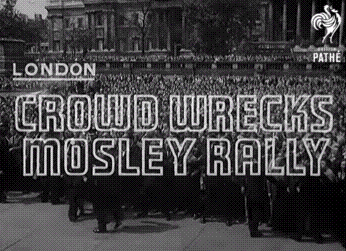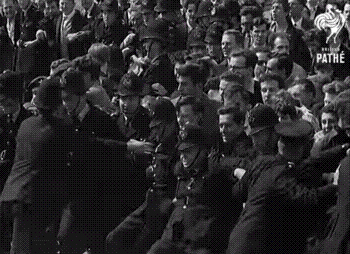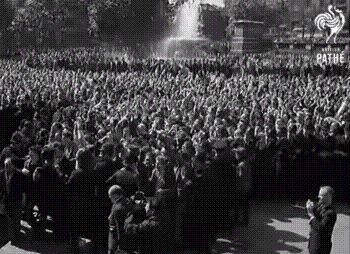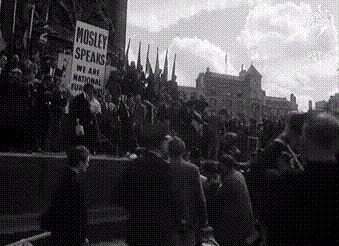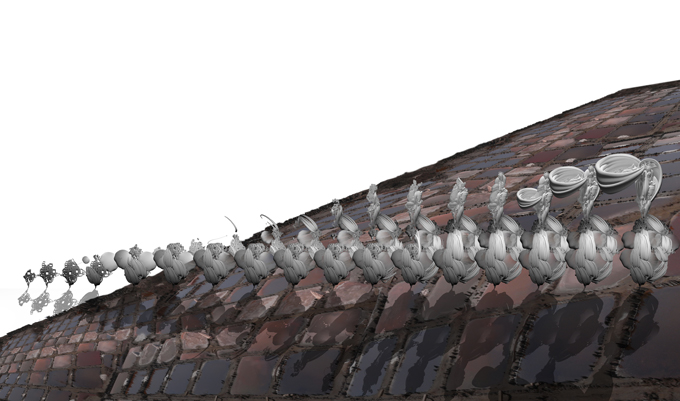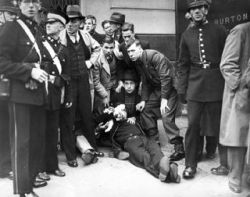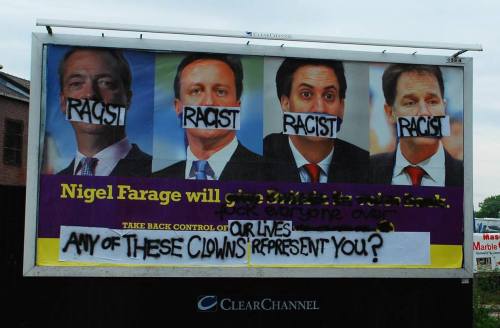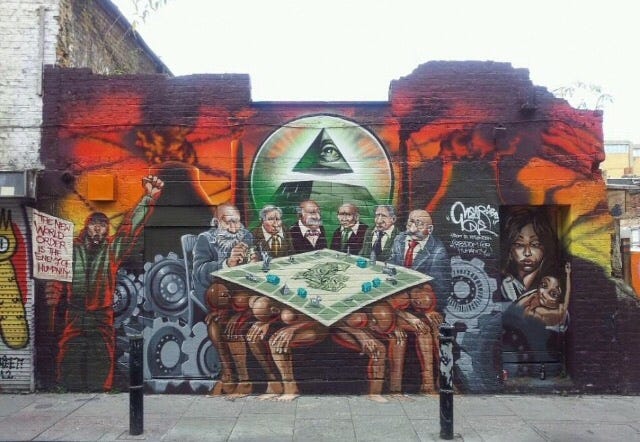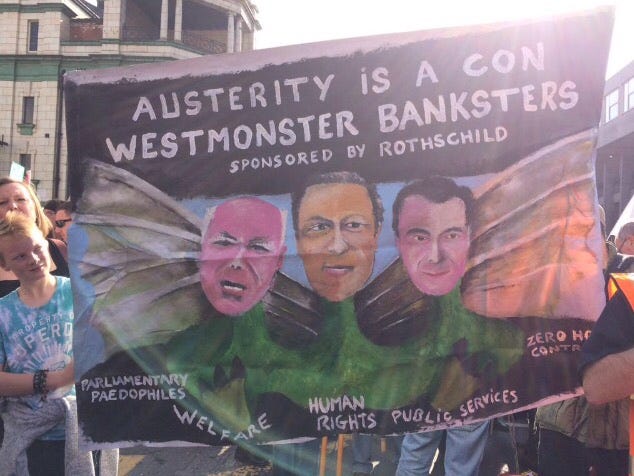A New Chapter in the Fascist Internationaleby ALEXANDER REID ROSSWith an insignia of a shield crossed by broadswords on a granite background, the World National-Conservative Movement announced its birth with the declaration, “The time has arrived to take responsibility for our peoples and nations of the world!” The confluence of some 58 parties, organizations, and groups, the World National-Conservative Movement (WNCM) developed out of the efforts of the Russian radical-right party, Rodina.
While its public document declares that “Communism, Nazism, and Islamism” comprise a “false alternative to totalitarian ideologies,” the WNCM’s ideology reads like a run-of-the-mill document of the radical right, which remains inextricably linked to fascism. Lamenting the sexual perversity of the super-national organizations like the EU and NATO, and calling for the return to the traditional “family and healthy moral values,” the WNCM attacks “the erosion of nations, massive migration,” which it blames on “liberalism, multiculturalism, and tolerance.” Instead, WNCM advocates “healthy nationalism and religious beliefs, patriotism, respect of one’s own and foreign traditional moral and ethical values, in other words, national conservatism.” Subverting the “global cabal” (read: Jews) requires a chain of “conservative revolutions” that will restore nations to themselves; “Victory of the conservative revolution even in one country without fail will provide an example for other countries.”
With participants including Golden Dawn, Jobbik, the Finns Party, and the British National Party, the WNCM hosts some of the most powerful radical right populist names in Europe. However, the umbrella group also includes some overtly-fascist groups and groupuscles like Poland’s Falanga, Italy’s Millennium and Forza Nuova, and the US’s American Freedom Party. Visiting senior fellow at London’s Legatum Institute, Anton Shekhovtsov, who broke this story on Thursday, characterizes the group as “clearly on the extreme right, verging on neo-Nazism.” That is putting it lightly. In spite of its formal denial, the WNCM seems more like a continuation of a potentially-disastrous formula combining fascist vanguards and populist radical right parties that continues to build steam around the world.
The Origins of the Fascist InternationaleIn broad terms, it a “Fascist Internationale” that seems to be in the offing in the World National-Conservative Movement. The notion of a “left-wing” fascism, or a fascist system that would respect the autonomy of different nations while working co-operatively, developed out of the original “National Bolshevik” group, Association for the Study of Russian Planned Economy (ARPLAN), which featured Ernst Jünger and Georgi Lukacs, among others. These thinkers ideated, against the Hitlerite faction of National Socialism, that a bond between the Soviet Union and Nazi Germany could work, because, in the words of völkisch thinker Artur Dinter, Bolshevik Russia would become “a ‘Russian National Socialism.’”
While ARPLAN found significant traction in the early Nazi Party, with Gregor Strasser featuring prominently as Hitler’s number two, their hopes would be dashed in the Night of the Long Knives. Gregor was murdered, and his brother Otto fled the country. After the war, Otto Strasser rose to prominence on the neo-fascist circuit along with French intellectual, Maurice Bardèche, Italian occultist Julius Evola, US agent Francis Parker Yockey, and Belgian odd-ball Jean-François Thiriart. These thinkers helped model a European Social Movement (known today as the “second position”) that looked to a European Nation highly influenced by British fascist Oswald Mosley’s Union Movement. The European Social Movement effectively passed out of existence by 1957, due to a split over the difference between racist politics and cultural hegemony. Although the idea of a European Nation continued, a “Third Position” would develop to carry on the banner of “neither left nor right, neither communist nor capitalist.”
After the decline of the European Social Movement, US fascist leader George Lincoln Rockwell set up a World Union of National Socialists (WUNS) in 1962 with founder of the White Defense League (predecessor to the current English Defense League) and British National Party, Colin Jordan, at the helm. While the WUNS is still around, it lacks the Strasserist edge, the focus on cultural hegemony, National Bolshevism, and Eurasianism, that has stimulated the supposedly anti-Imperialist politics that accompanied the outbreak of the Third Position. Another movement continued to build through European conferences and journals of the neo-fascist movement.
In the words of Francis Parker Yockey’s two-volume Imperium, “The Internationale of our times appears in a time when the Spirit of the Age has outgrown political nationalism. The Age of Absolute Politics will not tolerate petty-Stateism [sic].” Antagonistic to NATO forces in Europe, the neo-fascist movement developed a two-tiered dual power strategy known as the “strategy of tension” to at once gradually infiltrate European government and form direct action groups to engage in terrorist attacks that would push the citizenry closer to State protection. As fascist agents entered the governments of Perón’s Argentina and Nasser’s Egypt, a “true” Internationale seemed possible, if not in name then in deed. However, the negation of the modern nation-state required renewed cultural efforts to not only loosen the tension, but reposition politics in the aristocratic world of Empire. That is where Alain de Benoist entered the scene.
First affiliated with the fascist (Yockeyist) publication Western Destinies, Benoist joined the left-to-right magazine L’Idiot International, started by Jean-Edern Hallier with the initial support of Sartre and Beauvoir (though the latter distanced herself from the publication fairly quickly). As he climbed through the ranks of the post-68 political miasma, Benoist became the cultural editor at Le Figaro, and exploded onto the intellectual scene during the “hot summer” of 1979. It was the year after Italian authorities incarcerated Antonio Negri for allegedly masterminding all of European terrorism from his small professor’s office in Padua, Italy, and the “Gramsci of the Right,” Alain de Benoist, helped to fill the empty space.
Sponsored by Marco Tarchi in Italy and the National Front’s Michael Walker in Britain, among others, the New Right affected a strategy of cultural hegemony to embrace the diversity and “grey eminences” of European life. With direct affiliations to National Bolshevism and Third Positionism, the New Right tethered a kind of sophisticated fascist cultural subtext to Italian terrorism and skinhead street violence. The themes of the revolutionary “new man” through the rebirth of European cultural greatness gained currency not only on the right, but on the left as well. In 1992, during the collapse of the Soviet Union, the New Right passed the proverbial baton to the New Russia.
About Russian PoliticsRussian politics is sensitive business. Accusations of affiliation with the KGB were virtually ubiquitous throughout the radical right during the collapse of the Soviet Union (and in some cases not unfounded). One of the early converts to the idea of pan-European right wing through an International Center of Right-wing Parties, Zhirinovsky developed important ties to Western right-wing populist parties like the National Front almost overnight. Key technological contributions from Le Pen in 1992, as well as an early relationship with elements of the New Right, helped galvanize his career at the Liberal Democratic Party of Russia, a party that Stephen Shenfield describes as “a nationalist and imperialist ideology of a composite liberal-fascist character.”
While Zhirinovsky, with his thick-rimmed glasses and burly figure, has become the perennial bully of Russian politics, the ideological slant of the modern radical right comes from Alexander Dugin, who the National Review called an “evil” ringleader of a “Satanist cult” last year (so much for conservatism). Craving a truly “fascist fascism,” Dugin became attached to Zhirinovsky early on through the powerful nationalist movement, Pamyat, which featured a swastika in the center of its official symbol. Dugin’s ideal of a pan-European “large space” (Grossraum) of Eurasia is modeled after the ideas of Rudolph Hess’s mentor, Karl Haushofer, and gained key early allies from the New Right.
The solidarity of Eurasianism calls for something completely new, beyond right and left, against all preconceived notions that divide, against communism, fascism, national socialism, racism, materialism. Instead, Dugin calls for a “Fourth Political Theory” beyond the Strasserist Third Position, calling for a reduction that includes freedom from the “first position” (Nazism and Fascism), social justice from the “second position” (European Social Movement), and “traditional identity” from the Third Position. With its roots in the three forms of 20th Century fascism, the “fourth position” Eurasianism and its friends in formal populist radical right parties provides a serious challenge to the supporters of the EU. That the discourse of the fourth position circumvents racism through the overwrought detour of torture provides testimony to the unpopularity of neo-fascism’s ontological positions, however. This is why Dugin insists that not a mass movement, but a “qualified minority” is required to develop the conservative revolution.
A member of the National Bolshevik movement, which ended its collaboration with Zhirinovsky after discovering his Jewish ancestry, Dugin’s influence is inescapable on the radical right today. The figure Dugin is most clearly connected with is a former expatriot and decadent named Limonov, who said of Zhirinovsky, “a Jew masquerading as a Russian nationalist is a sickness.” While Limonov may have worked with Zhirinovsky in 1992 to help him with European contacts, he took leave of his place at the Liberal Democratic Party of Russia, and developed an independent pseudo-political career melding Stalinism and Hitlerism into a cult of the self. Formerly of the Studio 51 disco-punk scene of New York’s seedy underbelly, Limonov moved to France, where he grew to know the leader of Europe’s New Right movement, Alain de Benoist, and the Maoist-fascist Jean-François Thiriart. It was through this pedigree that he became the leader (though not undisputed) of the Europe’s National Bolshevik movement to overthrow parliamentary democracy and replace it with a fascist Internationale.
As a metric for the position of Rodina, which spearheads the movement to create a pan-Eurasian movement and the WNCM, the drunken bear of the Russian radical right, Vladimir Zhirinovsky, finds Rodina extreme. Its name meaning “Motherland,” Rodina stands tall among the Russian radical right. In 2005, while namby-pamby Putin was commemorating Auschwitz, Rodina joined Zyuganov’s Communist Party of the Russian Federation (the remnants of the old Communist Party of the Soviet Union) in calling for an outright ban of Jewish organizations. That same year, Zhirinovsky conducted a walkout of the Russian Duma, but words muttered underneath the breath of Rodina’s Andrei Saveliyev sparked an extended brawl that sent the two tumbling around in the isles. In the aftermath, Zhirinovsky got Rodina banned from a regional election for circulating an advertisement featuring a sidewalk littered with watermelon rinds and the comment: “Let’s clean up the trash from our city.”
The Brown ListThe year after the rumble in the Duma, a coordinating organization of fascist parties and groups called the European National Front emerged, including many who now make WNCM their roost: Italy’s Forza Nuova, the National Democratic Party of Germany, Renouveau Français, and Golden Dawn. Among others, the European National Front was co-founded by Roberto Fiore, formerly of the Italian terrorist group Terza Posizione, who fled charges of participating in a bombing of a Bologna train station in Italy for the posh London digs of British New Rightist, Michael Walker. Although the European National Front dissolved in 2009, many of its old alliances and connections began to reconnect during the ouster of Yanukovich in Ukraine sponsored by pro-EU forces in the winter of 2013-2014, which included some well-known fascist groups like Svoboda and Right Sector. Responding to pro-EU fascism, National Bolshevik and Eurasian fascist groups like Hungary’s Jobbik, Italy’s Millennium, Poland’s Falanga and Ruch Narodowy, and the Franco-Serbian joint project, Unité Continentale, joined up with separatists in the east, and attempted to create ethno-separatist movements in the west. All four groups are currently featured along with the “not dead yet” British National Party on the WNCM’s roster.
Out of renewed organizing efforts against “global hegemony” after the Crimea Crisis came the Alliance of Peace and Freedom last year, cobbled together out of the old European National Front by Nick Griffin, and featuring the National Democratic Party of Germany, Golden Dawn, and Forza Nuova. In March of this year, on the anniversary of Russia’s annexation of the Crimea, Rodina convened the International Russian Conservative Forum in St Petersburg. Originally boasting the participation of the entire Alliance of Peace and Freedom, along with the Austrian Freedom Party and the cultural wing of Italy’s Northern League, the International Russian Conservative Forum laid the seeds for the WNCM.
One only has to look at the list of groups in line with the World National-Conservative Movement (WNCM) to catch a glimpse of its geneology. The denomination of “revolutionary conservative” that it uses developed out of the New Right’s attempts to avoid the label of “fascist” by adopting as its intellectual figureheads people like Martin Heidegger, who extolled the “inner truth and greatness of national socialism,” Carl Schmitt, who formalized the juridical side of Grossraum, and Ernst Jünger, who sent Hitler an autographed copy of his essay “Fire and Blood,” and later served on the staff of the military occupation of Paris, overseeing the execution of deserters with “higher curiosity.” In a recent lecture during the conference, Grossraum: Russia and Europe: Dialogue of Resistance, Alexander Dugin lists off a number of fascists of the “old generation,” including Thiriart, and calls on his young audience to take up the banner of “new conservatives” comparing them to “the first Christian martyrs” as “fighters” against the “global hegemony” and the “money and so-called human rights” that “perverts nature.”
One of the top representatives of the New Right in the WNCM’s inaugural list is Tom Sunic from Croatia, who appeared in an interview with Alain de Benoist, himself, for the Holocaust-denying organ Institute for Historical Review. Also represented in the WNCM is the 1-2,000-member Romanian Noua Dreaptă, whose name literally means “New Right.” With a deep reverence for the old Iron Guard, Noua Dreaptă members famously attacked a Gay Pride march in 2006 and a Hungarian celebration in 2008.
Leftism and RightismMost of the members of the WNCM have welfare chauvinist views that can take on the semblance of leftist politics. The early warning sign for the creation of the Russia-oriented WNCM might have been in December, 2014, when Moscow hosted a conference including WNCM collaborators (League of the South and Rodina, for instance) called “Right of Peoples to Self-Determination and Building a Multi-Polar World.” While the Multi-Polar World conference attacked “predatory foreign policy of the US and its NATO allies” and included US leftists with the Workers World Party, it bent heavily toward Dugan’s brand of fascism. It would not be surprising to see future conferences and groupings in which certain leftist groups are integrated with or within the WNCM.
The creation of the WNCM indicates a growing international solidarity between revolutionary fascist groups from South Africa, Syria, Chile, and Japan, which share similar ideologies. If it may not be true that the organizations outside of Europe have less representation, in spite of the WNCM’sclaims that it is “formed on a voluntary and equal basis by representatives of various countries and peoples,” they remain largely white supremacist and white separatist. Many of the groups listed by the WNCM are also immediately dangerous to immigrants, people of color, and LGBTQA people.
The connections between Jobbik, Golden Dawn, and the British National Party to anti-immigrant, anti-Semitic, and racist violence are well known, and the WNCM’s list deepens the connection. Fiore notoriously organized Europe’s Hammerskins a few years prior to founding the European National Front in 2006. What is more troubling, Shekhovtsov points out, is that the WNCM’s program identifies “joint camps for military and athletic instruction” as part of the agreement. These “joint camps” are, most importantly, part of the Eurasian movement, which is represented by Unité Continentale, Belgium’s Euro-Russia, Ukraine’s Network Carpatho-Russian Movement, and Germany’s Die Russlanddeutschen Konservativen.
The association of the Finns Party, as well as the other populist groups, is also noteworthy. The second largest party in Finnish parliament, the Finns Party received nearly 18% of the vote in this year’s election. They are known for economic leftism mixed with nationalist policies that include the sterilization of African immigrants. Another WNCM member, Poland’s Kongres Nowej Prawicy, won four seats in last year’s disastrous European Parliament election. WNCM participant, the National Democratic Party of Germany, also won a seat in European Parliament, and its representative, Udo Voigt, is on the WNCM’s “esteemed” guest list.
A small joke lies at the bottom of the insistence on the “qualified minority”—particularly glancing over the US’s participants in the WNCM, which include the League of the South and the American Freedom Party. While these groups boast some impressive political ties to a host of more-prominent right-wing organizations like the white separatist Council of Conservative Citizens, as well as pan-separatist groups linked to the fourth position, they remain relatively miniscule compared to groups like Jobbick. Seeking representation for “European Americans,” the American Freedom Party emerged from the American Third Position, which in turn came from the Golden State Party, established by a fascist skinhead gang. Their auspices have not improved much. However, the name American Renaissance does provide a glimpse into an increasingly revolutionary tilt to conservatism in US politics, which could prove more auspicious for international fascism.
Revolution and RenaissanceEstablished and edited by the New Century Foundation’s Jared Taylor, who joins David Duke in the WNCM, American Renaissance magazine fills its pages with attacks against “welfare mothers” and articles on eugenics, while annual American Renaissance conferences play host to Nick Griffin and the Front National’s Bruno Gollnisch. However, Taylor’s fourth position philosophy enables the inclusion of Jews in his conferences, bringing an awkward air of confusion to other contributors like Stormfront’s Don Black and Jamie Kelso (formerly of the American Third Position). After an explosion of controversy following a 2006 disruption led by David Duke, in which he insisted that the New Right speaker Guillaume Faye “touched my genes,” exciting him to “rise and defend… and restore our heritage” against the internal subversion of “another non-European… Middle Eastern community… that dominates our media, influences our government, and has led us to this internal destruction of our will and our spirit.” Duke was interrupted by Jewish astrophysicist Michael Hart, who cried out, “You fucking Nazi, you’re a disgrace to this meeting!” Faye responded (Faye’s response beginning at 4:35), “you cannot directly speak about the Jews as the cause that arrived to us, but worse than the Jews are the … Jews in the mind[.]”
The American Renaissance was forced to sharpen its position around separatism. In a 2013 conference in Tennessee, Matthew Heimbach, a rising leader in the “white movement,” asked speaker Paul Ramsey “How do we create our ethno state?” The latter responded, “We need to Balkanize, and create our own homeland.”
That year was a difficult one for Mr. Heimbach. After appearing at an event put on by fascist skinhead gang, Aryan Terrorist Brigade, the National Socialist Movement, and the Imperial Klans of America, Heimbach found himself excommunicated from the League of the South, but they reinstated him soon after. The director of the Traditionalist Youth Network, Heimbach has since given tailgate speeches in defense of the Confederate flag, and after paying homage to the families of Dylann Roof’s victims, declared, “Dylann Roof is a victim in regards to he was a white man born to a society that actively hates him and hates his people, hates his culture and his identity.” Heimbach hopes to provide a framework “to make victories in the political sphere” by uniting fascist groups around the US.
Although Heimbach’s softer rhetoric has brought him beneficial media attention on Al Jazeera and Russia Today, his baseline politics are grounded in forced removal of people of color from a “white homeland,” along with the violent liquidation of sexual diversity. Heimbach’s “solidarity” for Palestinians is exposed also by his avowed support for the Assad regime in Syria, Golden Dawn, and Russian nationalists. Writing about the Russian International Conservative Forum that prefigured WNCM, Heimbach declared, “To break the chains of oppression that are keeping our people down, Europeans must rally together to create a Traditionalist International. Russia has the finances and the spiritual position to be a leader in uniting various nationalist and Traditionalist factions to work to destabilize and eventually destroy the agenda of the European Union, NATO and the United States. By pushing for a new global crusade against the enemy we are beginning a Holy war [sic] to save everything that we hold dear.”
While his anti-Americanism has rubbed some conservatives the wrong way, Heimbach’s “revolutionary traditionalism” falls into line with the European radical right, as well as the fascist vanguardists. The perspective of the fourth position is something that one might call über-fascism—it is, in a way, over the label of fascism, while retaining its characteristic “palingenetic ultranationalism,” and looking for appropriate political opportunity structures to disseminate its creed. The anger brought by the tenure of Obama has led to an increasingly revolutionary ideological position against NATO, while furthering important fascist entryism into the conservative movement. This revolutionary conservative movement finds its main mouthpiece in Donald Trump, who has proclaimed his intention to “get along very well with Vladimir Putin.”
It may be that Trump is already more like a US version of Zhirinovsky: a kind of popular burlesque sideshow with tremendous political power. Should Trump be elected to the office of president, however, there is a strong likelihood that the stature of the League of the South, American Renaissance, the American Freedom Party, and groups like it, would gain a great deal of power—much like Rodina in Russia. That scenario would prove deadly for the geopolitical composition of the world as we know it.
Alexander Reid Ross is a contributing moderator of the Earth First! Newswire. He is the editor of Grabbing Back: Essays Against the Global Land Grab (AK Press 2014) and a contributor to Life During Wartime (AK Press 2013). His most recent book Against the Fascist Creep is forthcoming through AK Press. 



